Struggling with sneezing and itchy eyes around your furry friend? Discover 7 proven strategies for managing pet allergies while keeping your beloved pets close in this comprehensive guide.
Table of Contents
ntroduction

For the 15-30% of Americans who suffer from allergies, the love for pets often comes with an uncomfortable price. Managing pet allergies while maintaining a happy home for both two-legged and four-legged family members can feel like walking a delicate tightrope. At BlithePet, we understand this challenge and have compiled comprehensive strategies to help allergy sufferers coexist peacefully with their beloved animal companions.
Pet allergies don’t simply manifest as occasional sneezing; they can significantly impact quality of life with symptoms ranging from persistent congestion to severe asthma attacks. According to the Asthma and Allergy Foundation of America, approximately 30% of people with allergies have allergic reactions to cats and dogs, with cat allergies being about twice as common as dog allergies.
The good news? With proper management techniques, medication advances, and smart home modifications, families don’t have to choose between their health and their furry family members. This guide explores seven proven strategies for effectively managing pet allergies while maintaining the special bond you share with your pets.
Understanding Pet Allergies: The Science Behind the Sneezes

Before diving into management strategies, it’s crucial to understand exactly what causes pet allergies. Contrary to popular belief, it’s not actually pet fur that triggers allergic reactions.
What Really Causes Pet Allergies?
Pet allergies are triggered by proteins found in:
- Dander: Tiny, sometimes microscopic, flakes of skin shed by cats, dogs, rodents, birds, and other animals with fur or feathers
- Saliva: Especially problematic with cats who groom themselves frequently
- Urine: Particularly relevant for small caged pets like hamsters, guinea pigs, and rabbits
- Sebum: Oil secreted by sebaceous glands that keeps skin and fur healthy
These proteins become airborne as microscopic particles and can remain suspended in the air for hours. They easily stick to furniture, clothing, walls, and other surfaces, making them difficult to eliminate entirely. When inhaled by sensitive individuals, these allergens trigger the immune system to overreact, producing symptoms ranging from mild irritation to severe respiratory distress.
Common Symptoms of Pet Allergies
Pet allergy symptoms can range from mild to severe and may include:
- Sneezing and runny nose
- Facial pain from nasal congestion
- Coughing, chest tightness, and wheezing
- Shortness of breath
- Watery, red, or itchy eyes
- Skin reactions including hives or eczema
- Worsening of asthma symptoms for those with asthma
A study published in the Journal of Allergy and Clinical Immunology found that individuals with pet allergies who were exposed to high levels of pet allergens had a 67% higher risk of developing asthma than those with limited exposure.
1. Create Allergy-Free Zones in Your Home
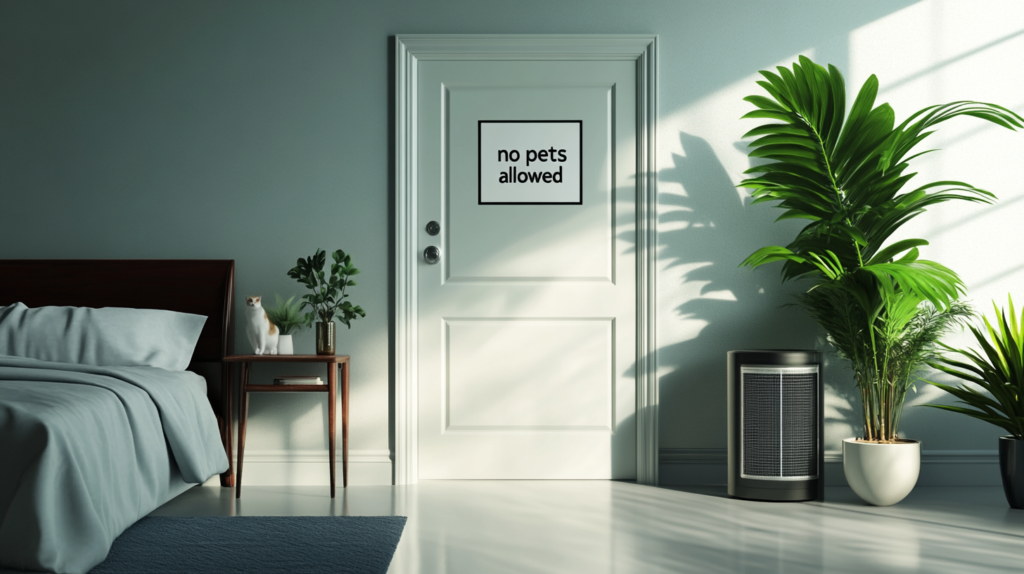
One of the most effective strategies for managing pet allergies is establishing designated pet-free areas within your home. These allergen-controlled sanctuaries provide allergy sufferers with spaces where they can retreat for symptom relief.
Designating Pet-Free Spaces
The bedroom should be your top priority when creating allergy-free zones, as most people spend about one-third of their lives sleeping. Consider implementing these measures:
- Keep bedroom doors closed at all times to prevent pet entry
- Install high-efficiency air purifiers specifically designed to trap pet allergens
- Use allergen-proof covers on mattresses, box springs, and pillows
- Wash bedding weekly in hot water (at least 130°F/54°C) to kill dust mites and remove allergens
- Consider removing carpeting or area rugs where allergens can accumulate
Dr. Sarah Johnson, an allergist at the National Allergy Center, explains: “Creating even one room in your home that’s completely free of pet allergens can significantly reduce allergy symptoms and improve sleep quality for sensitive individuals. The bedroom is the most logical choice since quality sleep is essential for overall health.”
Transitioning Your Pet to New Boundaries
Teaching your pet to respect these new boundaries requires patience and consistency:
- Establish the new rules from day one and be consistent
- Use positive reinforcement when your pet respects the boundaries
- Provide comfortable alternative spaces for your pet to enjoy
- Consider using baby gates or pet barriers rather than closed doors when possible
- Make sure all family members enforce the same rules
2. Implement Strategic Cleaning Routines
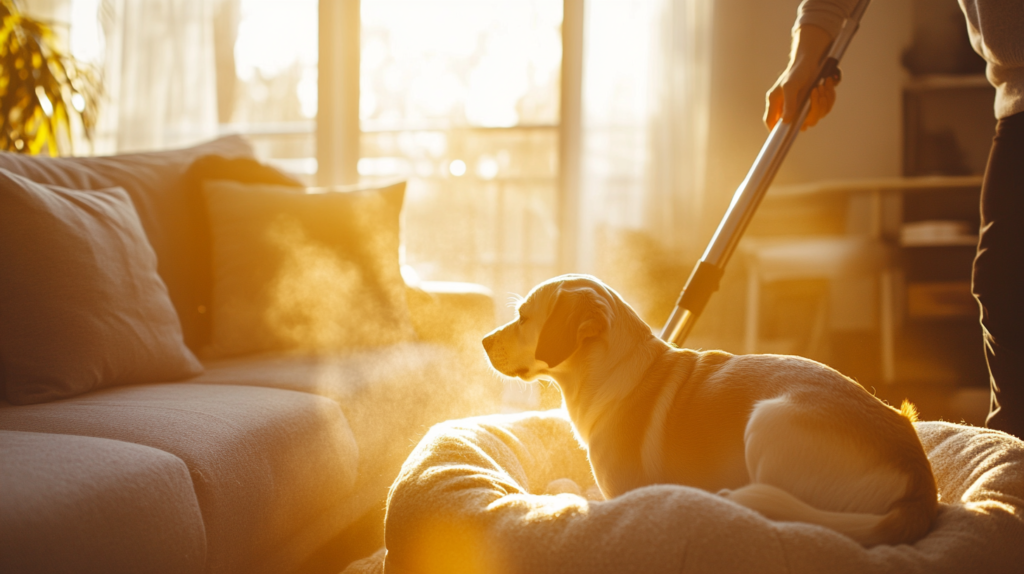
Regular cleaning is your first line of defense against the accumulation of pet allergens in your home. However, not all cleaning methods are created equal when it comes to managing pet allergies.
Effective Cleaning Technologies and Methods
To maximize allergen removal, consider these specialized cleaning approaches:
- HEPA vacuum cleaners: Use vacuums with High-Efficiency Particulate Air (HEPA) filters that can trap particles as small as 0.3 microns, including pet dander. A study in Environmental Health Perspectives found that regular HEPA vacuuming reduced airborne pet allergen levels by up to 50%.
- Microfiber tools: Microfiber cloths and mops can trap more dander and allergens than traditional cleaning tools due to their electrostatic properties.
- Steam cleaning: The high temperature effectively kills dust mites and can help break down pet allergen proteins on upholstery, curtains, and carpets. Aim to steam clean these surfaces every 2-3 months.
- Hard surface focus: Replace carpets with hardwood, tile, or laminate flooring which don’t trap allergens like carpeting does. Research shows that carpeted homes can contain up to 100 times more pet allergens than homes with hard flooring.
Pet-Friendly Cleaning Products
When choosing cleaning products, look for options that are:
- Fragrance-free to avoid irritating sensitive airways
- Non-toxic for pet safety
- Enzymatic cleaners specifically formulated to break down pet proteins
A cleaning schedule template for allergy sufferers with pets:
| Area | Frequency | Recommended Method |
| Floors | 2-3 times weekly | HEPA vacuum, followed by microfiber mopping |
| Upholstery | Weekly | HEPA vacuum with upholstery attachment |
| Bedding | Weekly | Hot water wash (130°F/54°C) |
| Air filters | Monthly | Replace or clean according to manufacturer instructions |
| Curtains | Monthly | Washing or HEPA vacuuming |
| Walls | Quarterly | Dust with microfiber cloth, especially in high-traffic pet areas |
| Ductwork | Annually | Professional cleaning |
3. Upgrade Your Air Quality Management
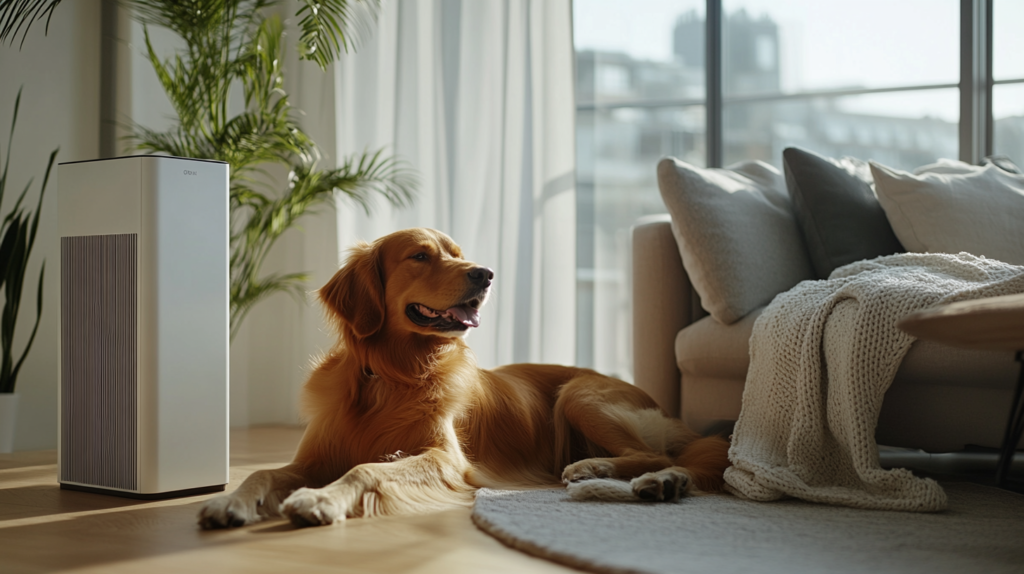
Indoor air quality plays a crucial role in managing pet allergies. Since allergens can remain airborne for hours, implementing effective air filtration strategies can significantly reduce symptoms.
High-Efficiency Air Purification Systems
When selecting an air purifier specifically for pet allergies, look for these features:
- True HEPA filtration: These filters capture 99.97% of particles as small as 0.3 microns, including pet dander.
- Activated carbon filters: These help remove pet odors along with some allergens.
- Appropriate sizing: Ensure the purifier is rated for your room size (check the Clean Air Delivery Rate or CADR).
- Air exchange rate: Higher air exchange rates (4-5 times per hour) are more effective for allergy sufferers.
According to a clinical study published in the American Journal of Respiratory and Critical Care Medicine, using high-efficiency air purifiers reduced pet allergen concentrations by up to 70% and decreased allergy symptoms by 40% among participants.
HVAC Considerations for Allergy Sufferers
Your home’s heating, ventilation, and air conditioning system can either help or hinder your allergy management efforts:
- Regular filter changes: Replace standard HVAC filters every 30-90 days, or more frequently during high-shedding seasons. Consider upgrading to MERV 11-13 rated filters which can trap pet dander.
- Duct cleaning: Have air ducts professionally cleaned every 3-5 years to remove accumulated pet allergens, especially after moving into a home previously occupied by pet owners.
- Humidity control: Maintain indoor humidity between 40-50%. Dust mites and mold—which can compound pet allergy symptoms—thrive in higher humidity environments.
- Fresh air exchange: While keeping windows closed can prevent outdoor allergens from entering, periodic air exchange is beneficial. Consider an energy recovery ventilator (ERV) system that exchanges indoor and outdoor air without significant energy loss.
Dr. Michael Roberts, an environmental health specialist, notes: “Many allergy sufferers focus solely on surface cleaning but neglect air quality management. Since we breathe approximately 20,000 times per day, airborne allergen reduction should be a priority in any comprehensive pet allergy management plan.”
4. Adopt Regular Pet Grooming Practices
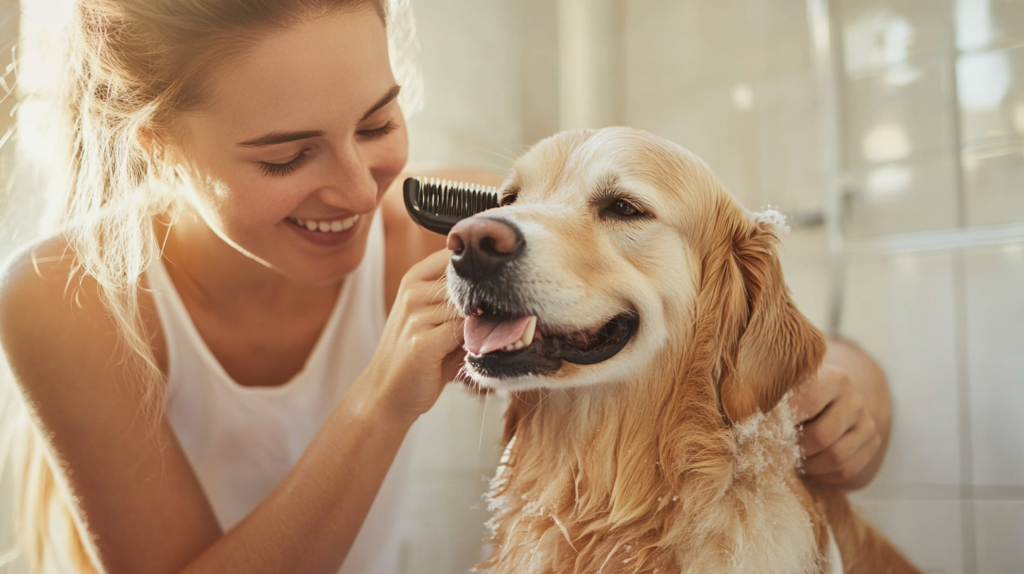
Proper pet grooming is one of the most direct ways to reduce allergen levels at their source. Regular grooming removes loose fur and dander before they can spread throughout your home environment.
Effective Grooming Routines
For optimal allergen reduction, implement these grooming practices:
- Frequency matters: Brush your pet daily if possible, or at minimum 2-3 times weekly. This is particularly important during seasonal shedding periods.
- Outdoor grooming: When weather permits, brush pets outdoors to prevent allergen dispersal inside your home.
- Professional services: Schedule professional grooming appointments every 4-6 weeks for more thorough cleaning and dander removal.
- Bathing schedule: Regular bathing can reduce allergen levels on your pet’s coat by up to 84% according to a study in the Journal of Allergy and Clinical Immunology. Consult your veterinarian for the appropriate bathing frequency for your specific pet.
Best Tools and Products for Allergen Reduction
Invest in proper grooming equipment designed specifically for allergen control:
- High-efficiency pet brushes: Look for designs that trap and contain shed fur rather than releasing it into the air.
- Pet-specific vacuums: Some vacuums are designed with attachments specifically for direct pet grooming.
- Specialized pet wipes: For quick daily cleanings between baths, allergen-reducing pet wipes can help remove dander and saliva proteins.
- Dander-reducing shampoos and sprays: Products containing moisturizers can help reduce dry skin and dander production.
When to Seek Professional Help
While home grooming is effective, some situations call for professional assistance:
- For pets with thick double coats that require de-shedding treatments
- When dealing with severe matting that may trap allergens
- For pets who are resistant to home grooming efforts
- During heavy seasonal shedding periods
Pet groomer Monica Rivera explains: “Professional groomers have specialized high-velocity dryers that remove dander and loose fur at levels impossible to achieve with home grooming. For allergy sufferers, the investment in regular professional grooming often pays for itself in reduced medication needs and improved quality of life.”
5. Explore Medical Management Options
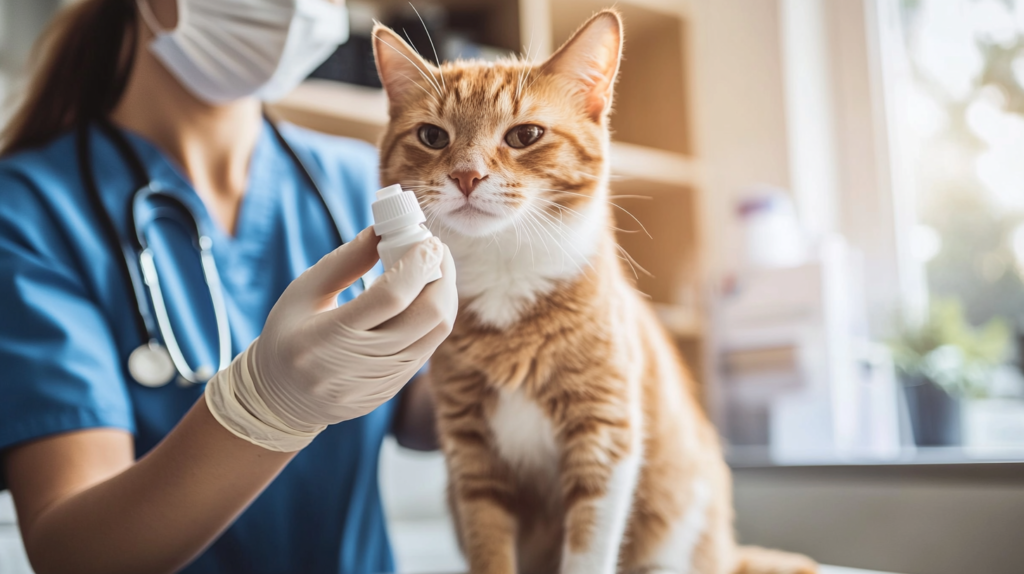
While environmental modifications are essential, medical interventions often play a crucial role in comprehensive pet allergy management. Both over-the-counter and prescription options can provide significant relief.
Medications for Managing Pet Allergies
Several medication types have proven effective for pet allergy symptoms:
- Antihistamines: These block the effects of histamine, reducing sneezing, itching, and runny nose. Options include cetirizine (Zyrtec), loratadine (Claritin), and fexofenadine (Allegra).
- Nasal corticosteroids: These reduce inflammation and are often considered the most effective medication type for allergic rhinitis. Examples include fluticasone (Flonase), budesonide (Rhinocort), and mometasone (Nasonex).
- Decongestants: These can help relieve nasal congestion but are typically recommended only for short-term use. Look for pseudoephedrine (Sudafed) or phenylephrine.
- Leukotriene modifiers: Prescription medications like montelukast (Singulair) can help block immune system chemicals that contribute to allergic reactions.
- Combination medications: Some products combine antihistamines with decongestants for broader symptom relief.
Immunotherapy: A Long-term Solution
For those with persistent and significant pet allergies, allergen immunotherapy (allergy shots) offers the potential for lasting improvement:
- How it works: Gradually introduces increasing amounts of pet allergens to your system, helping your body build tolerance over time.
- Effectiveness: Studies show that approximately 85% of patients experience significant symptom reduction after completing an immunotherapy protocol.
- Time commitment: Typically requires 3-5 years of regular injections, starting with 1-2 weekly shots during the build-up phase, then monthly maintenance injections.
- Newer options: Sublingual immunotherapy (allergy drops or tablets placed under the tongue) offers a needle-free alternative, though it’s currently less commonly prescribed for pet allergies in the United States.
Dr. Emma Chen, allergist and immunologist, advises: “Many patients try to manage with antihistamines alone, but combining medications—such as using both a nasal corticosteroid and an antihistamine—often provides superior symptom control. For those who don’t achieve adequate relief with medications, immunotherapy can be transformative, sometimes eliminating the need for daily medications altogether.”
When to Consult a Specialist
Consider seeking evaluation from an allergist or immunologist if:
- You’ve tried over-the-counter medications without adequate relief
- Your symptoms interfere with daily activities or sleep
- You have other conditions complicated by allergies (asthma, eczema, etc.)
- You experience side effects from allergy medications
- You want to explore immunotherapy options
An allergist can perform specific testing to confirm pet allergies and identify any additional allergens that may be compounding your symptoms.
6. Consider Breed-Specific Solutions

While no pet is truly 100% hypoallergenic, some breeds produce fewer allergens or shed less, potentially reducing allergic reactions.
Lower-Allergen Dog Breeds
Some dog breeds that often work better for allergy sufferers include:
- Poodles and Poodle mixes: Their curly coat traps dander and sheds minimally
- Bichon Frise: Has hair rather than fur and minimal shedding
- Portuguese Water Dog: Single-layered coat produces less dander
- Schnauzer: Less shedding and dander production
- Maltese: Minimal shedding with hair-like coat
Lower-Allergen Cat Options
For cat lovers with allergies, these breeds may cause fewer reactions:
- Siberian: Despite their fluffy appearance, they produce less of the Fel d 1 protein
- Balinese: Produces less of the primary allergenic protein than most cats
- Devon Rex and Cornish Rex: Have less fur to trap allergens
- Sphynx: While not fur-free, their lack of coat means less allergen-trapping capacity
Alternative Pets for Allergy Sufferers
If dog and cat allergies prove too challenging, consider these alternatives:
- Fish: Aquariums provide companionship without dander concerns
- Reptiles: Animals like bearded dragons and turtles don’t produce dander
- Birds: Some allergy sufferers can tolerate certain bird species, though feather allergies can be an issue
- Small mammals with contained habitats: Guinea pigs, hamsters, or gerbils kept in well-maintained enclosures may cause fewer issues
Dr. James Wilson, veterinarian and animal allergist, cautions: “While certain breeds may produce fewer allergens, individual sensitivity varies greatly. I always recommend spending significant time—ideally several hours on multiple occasions—with a specific breed or individual animal before adoption. What works for one allergy sufferer may not work for another, even with the same breed.”
7. Leverage Technology and Innovation
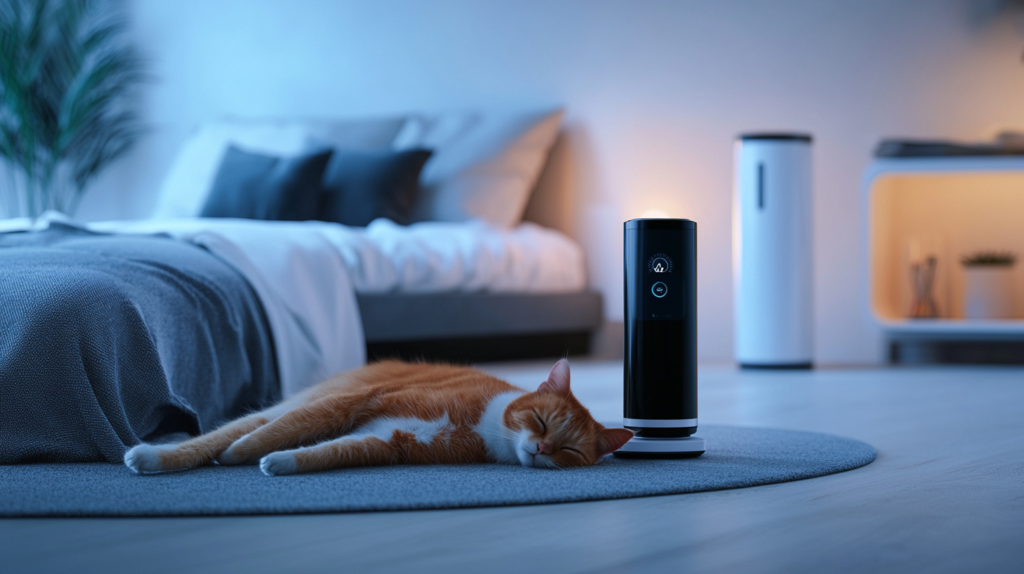
Recent technological advances offer new options for managing pet allergies beyond traditional methods.
Smart Home Technologies
Integrate these technologies for improved allergen management:
- Air quality monitors: Devices that measure particulate matter can help you track allergen levels in real-time and evaluate the effectiveness of your management strategies.
- Automated cleaning systems: Robot vacuums with HEPA filtration can be scheduled for daily cleaning, maintaining lower allergen levels between deep cleans.
- Smart HVAC filters: Systems that monitor filter status and alert you when replacement is needed help ensure consistent air filtration.
- UV air purifiers: Some advanced air purification systems include UV-C light technology that can help neutralize airborne allergens.
Innovative Pet Products
The pet care industry continues to develop products specifically addressing allergen concerns:
- Allergen-neutralizing sprays: Products containing specialized enzymes that break down the structure of allergen proteins, rendering them less reactive.
- Allergen-reducing pet wipes: Pre-moistened wipes formulated to remove dander, saliva, and other allergens from your pet’s coat between baths.
- Allergen-blocking topical products: Applied to your pet’s fur, these solutions aim to neutralize allergens at their source.
- Advanced dietary supplements: Some products claim to reduce dander production or alter the allergenic properties of pet saliva when added to pet food, though scientific evidence varies.
Emerging Research and Treatments
The field of allergy management continues to evolve with promising developments:
- Modified allergen immunotherapy: Researchers are developing more efficient protocols that may require fewer treatments with faster results.
- Monoclonal antibody treatments: Medications that target specific pathways in allergic responses are showing promise for various allergies, including pet allergies.
- Genetic modifications: Some research explores the possibility of breeding pets that produce fewer allergenic proteins.
- Microbiome research: Studies investigating how exposure to pets affects the human microbiome may lead to new preventive approaches for allergy development.
Technology expert and pet product developer Lisa Nguyen notes: “We’re seeing rapid innovation in the pet allergy space as the market for pet-friendly allergy solutions grows. While not every new product lives up to its marketing claims, we’re genuinely making progress in developing effective technological solutions that complement traditional management strategies.”
Living Harmoniously: Success Stories and Case Studies
The Thompson Family’s Journey
The Thompson family wasn’t ready to part with their beloved Golden Retriever, Max, when their youngest son developed allergies. By implementing a comprehensive management plan—including creating a pet-free bedroom, upgrading to whole-house HEPA filtration, and committing to twice-weekly professional grooming—they successfully reduced their son’s symptoms by approximately 80%.
“The key was consistency,” explains Jennifer Thompson. “We had to be diligent about our cleaning routine and medication schedule, but seeing our son able to play with Max without constant sneezing and itchy eyes made it all worthwhile.”
Single Solutions vs. Comprehensive Approaches
Research consistently shows that multi-faceted approaches yield the best results. A 12-month study of 67 families with pet allergies found that:
- Families using medication alone reported a 40% reduction in symptoms
- Families focusing solely on environmental changes saw a 35% improvement
- Families combining medical management, environmental controls, and pet care routines experienced a 78% reduction in allergy symptoms
This data underscores the importance of addressing pet allergies from multiple angles rather than seeking a single “silver bullet” solution.
Measuring Success in Allergy Management
How do you know if your management strategy is working? Consider tracking these metrics:
- Reduction in medication usage
- Improved sleep quality (fewer nighttime symptoms)
- Decreased frequency and severity of allergy attacks
- Better respiratory function measurements (if using a peak flow meter)
- Fewer sick days or disruptions to daily activities
Dr. Patricia Lee, allergy specialist, suggests: “Keep a simple symptom diary when implementing new management strategies. Rate your symptoms on a scale of 1-10 daily for two weeks before making changes, then continue tracking for at least a month afterward. This data can help you objectively evaluate what’s working and what needs adjustment.”
For more expert pet care tips and product recommendations, visit BlithePet.com — your trusted source for pet wellness.
Frequently Asked Questions About Managing Pet Allergies
Can someone develop pet allergies suddenly after years of having pets?
Yes, adult-onset allergies are common. The immune system can become sensitized to pet allergens over time, resulting in new allergy symptoms despite years of previous pet exposure without issues. Hormonal changes, stress, environmental factors, and cumulative exposure can all contribute to developing new allergies in adulthood.
Will getting an air purifier completely eliminate my pet allergy symptoms?
While high-quality HEPA air purifiers can significantly reduce airborne pet allergens, they typically won’t eliminate symptoms completely when used alone. Air purifiers work best as part of a comprehensive management strategy that includes regular cleaning, pet grooming, designated pet-free zones, and possibly medication.
Can children outgrow pet allergies?
Some children do outgrow allergies as their immune systems develop, but pet allergies often persist into adulthood. Research suggests approximately 20-30% of children with pet allergies may see symptom improvement or resolution over time. Early exposure to pets may actually reduce the risk of developing allergies in some children, illustrating the complex relationship between allergen exposure and sensitivity.
Is there a cure for pet allergies?
Currently, there is no permanent cure for pet allergies. Immunotherapy (allergy shots) is the closest option to a cure, as it can significantly reduce sensitivity over time by retraining the immune system. While not a cure, immunotherapy combined with environmental management can provide substantial long-term relief for many people with pet allergies.
Are certain pet foods better for reducing allergenic pet dander?
Some research suggests that high-quality pet foods rich in omega-3 fatty acids and antioxidants may help improve skin and coat health, potentially reducing dander. However, scientific evidence specifically linking diet to reduced allergenicity is limited. Consult with your veterinarian before making dietary changes intended to reduce allergens.
Can washing my pet weekly help with my allergies?
Regular bathing can temporarily reduce allergen levels on your pet’s coat by 84-85% according to research. However, these levels typically return to baseline within 3-7 days, making consistent bathing necessary for ongoing benefit. Work with your veterinarian to determine a safe bathing frequency for your specific pet, as over-bathing can cause skin issues in some animals.
Conclusion
Managing pet allergies successfully requires a multi-faceted approach tailored to your specific situation. By implementing the seven strategies outlined in this guide—creating allergy-free zones, strategic cleaning, air quality management, regular pet grooming, medical management, breed considerations, and leveraging technology—you can significantly reduce allergy symptoms while maintaining the special bond with your furry family members.
Remember that consistency is key, and what works for one person may not work for another. Be patient as you experiment with different combinations of strategies to find your optimal solution. For many families, the effort involved in managing pet allergies is well worth the joy and companionship that pets bring to our lives.
With advances in medicine, cleaning technology, and our understanding of allergies continuing to evolve, the future looks promising for allergy sufferers who wish to enjoy the benefits of pet ownership without constant discomfort.
Have a similar experience with your pet? Share it in the comments below!

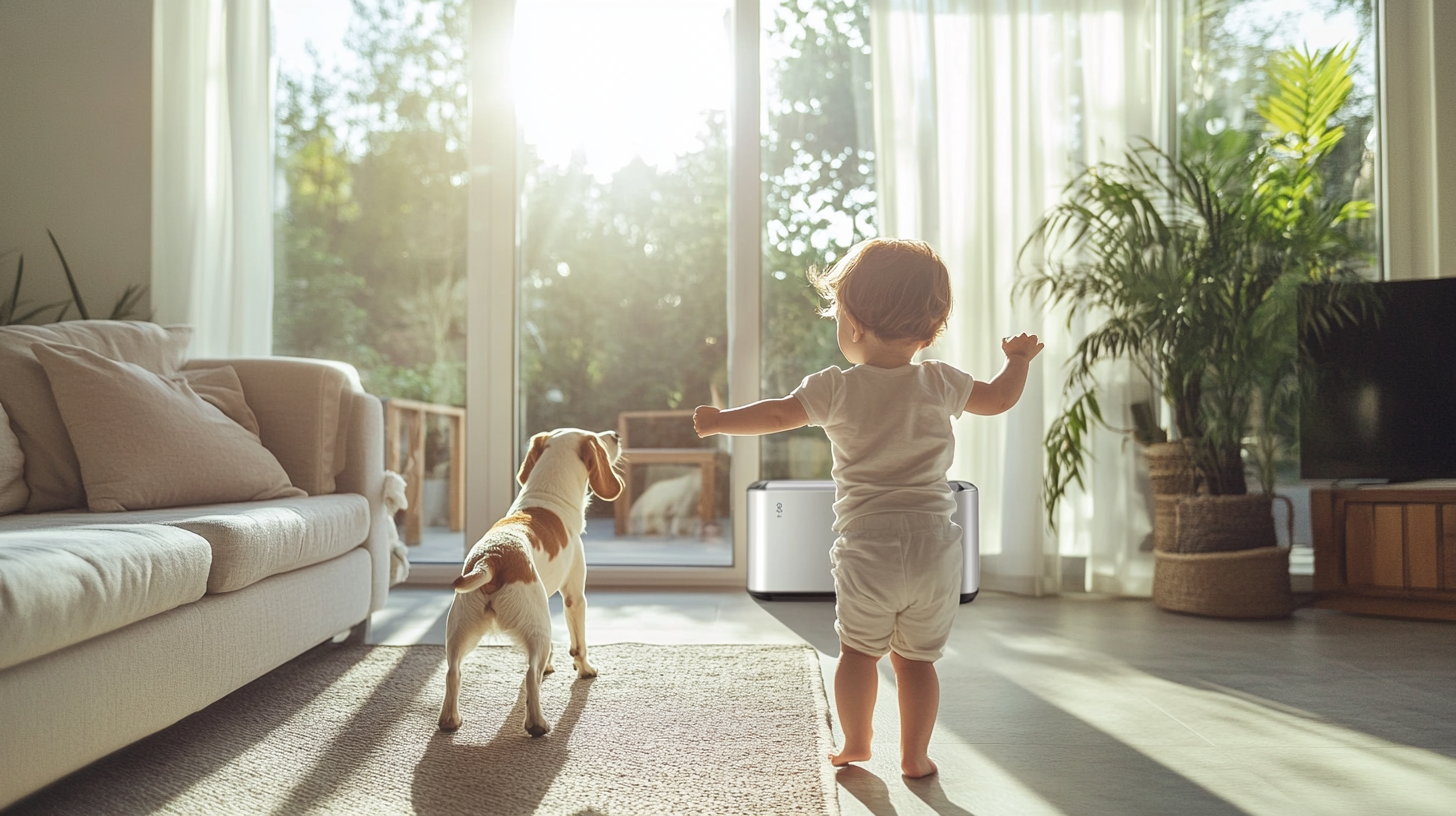

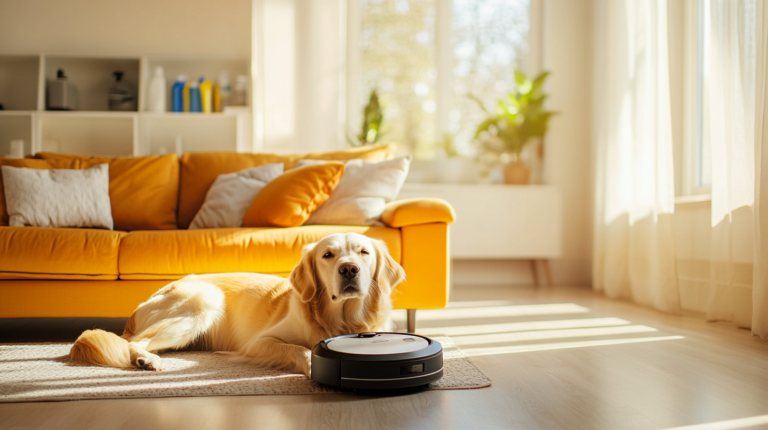
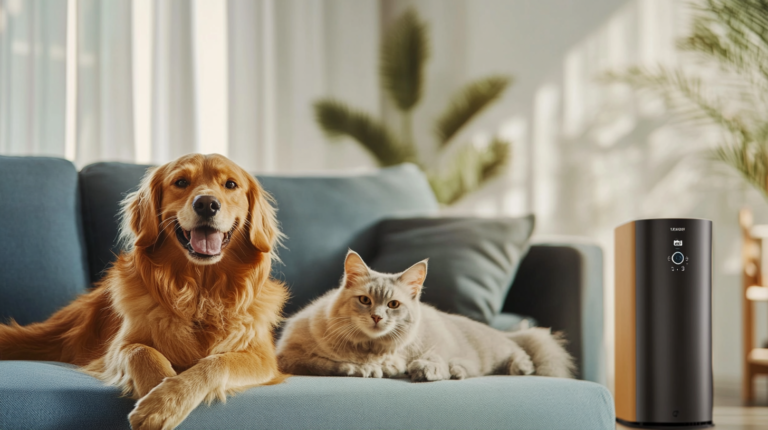



Leave a Reply